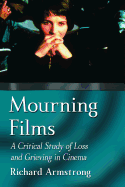In his book Mourning Films: A Critical Study of Loss and Grieving in Cinema Richard Armstrong argues a strong case for a new genre of films based around depictions of grief and loss. According to Armstrong’s definition, the ‘mourning film’ traces a protagonist’s emotional journey in the aftermath of loss as they negotiate the fallout of acute grief. These films, which focus largely on female characters, share a propensity for ‘muteness’ as language fails to expound the gravity of loss, protagonists who exhibit self-delusion and a loss of agency, the domestic sphere as a recurring setting and constant imagery of the ocean as a site of despair. Therefore, such films are a depiction of how mourning happens and, as Armstrong contends, validate cinema as “a means of moving beyond words to another means of negotiating death…” (41).
During his introduction, Armstrong makes a compelling case for the pure mechanics of cinema being a manifestation of presence and absence. This antinomy is a strong through line in Mourning Films particularly in discussions relating to spiritual appearances by the dead and the nature of memory as a means of ensuring that those passed remain with us. Such notions link Armstrong’s discussion to debates around ontology in Film Studies as the “precipitate presence” of death in the mourning film calls into question “…the veracity of what we see, while making it apparent that ‘something’ is present” (40). Although it is a bold claim, Armstrong believes “filmed images offer more astute ways into the experience of grief than words do” (8). This suggestion, which is expounded on thoughtfully and critically, not only substantiates the texts under discussion but also speaks strongly of film as a means of expressing loss with poignant insight.
Armstrong’s thesis moves fluently between psychoanalytic theory and the work of philosophers such as Deleuze and Daniel Frampton. However, most potently, Armstrong’s text draws on therapeutic literature around grief and loss. This is in keeping with the author’s hope that by “engaging with and exploring our feelings about material death and emotional loss, the mourning film can offer a space for dialogue around death and what it means to a society which no longer engages in structured mourning” (5). This quote marks the parameters of Armstrong’s study as he focuses his discussion on death and dying within Western culture.
The text itself is split into four chapters: Manifestation, Realization, Acceptance, and Release. These titles are emblematic of the emotional stages one moves through when facing loss, as well as simultaneously relating to the evolutionary stages of the genre. In terms of tracing the heritage of the mourning film, Armstrong argues that its classical stage lies in the high-melodrama of the ‘woman’s picture’ (or ‘female weepie’) and spiritual horror films like The Haunting(1963) and The Innocents (1961), before undergoing a modernist drive toward interiority in titles like Hiroshima Mon Amour (1959) and Don’t Look Now (1973). The mourning film reaches its post-classical stage during the last twenty years through titles like Three Colours: Blue(1993)where the excess of feelings and experimentation in earlier films is reconciled and the mourning film comes into its own (111).
Armstrong concludes each chapter with pertinent case studies, analysing films that best represent the genre at its various stages of evolution. Some of the stronger case studies are of films with well-established critical reputations. Thus readings of Hiroshima Mon Amour, Cries and Whispers (1972), Don’t Look Now and Three Colours: Blue represent four of Armstrong’s most successful case studies, particularly in their analysis of the protagonist’s interiority. Mourning Films does however provoke persuasive re-readings of lesser known titles under a new critical light, notably Woody Allen’s early drama Interiors (1978), and Jonathon Glazer’s poorly received Birth (2004). The commonalities that Armstrong identifies between seemingly disparate films dovetail nicely and pre-empt his formation of a ‘taxonomy of the mourning film’ in the final chapter.
The only false step in Mourning Films is the extended discussion of genre theory at the beginning of chapter four. At times this survey of the literature feels like a necessary evil Armstrong must undertake to justify his suggestion that the mourning film deserves classification as a genre in its own right. While Armstrong does an adept job of clarifying his evaluation of genre theory by exposing some of its evolutionary flaws, the result marks a slight interruption to a book that maintains such a compelling flow. Armstrong writes about grief with a quiet emotional tone that makes reading the book a moving experience in itself. So many of his interpretations and the affinities between these films speak to the real experiences of loss many readers will personally relate to. For these reasons Mourning Films is a successful foundation text in a sub-field of Film Studies that merits further exploration.

